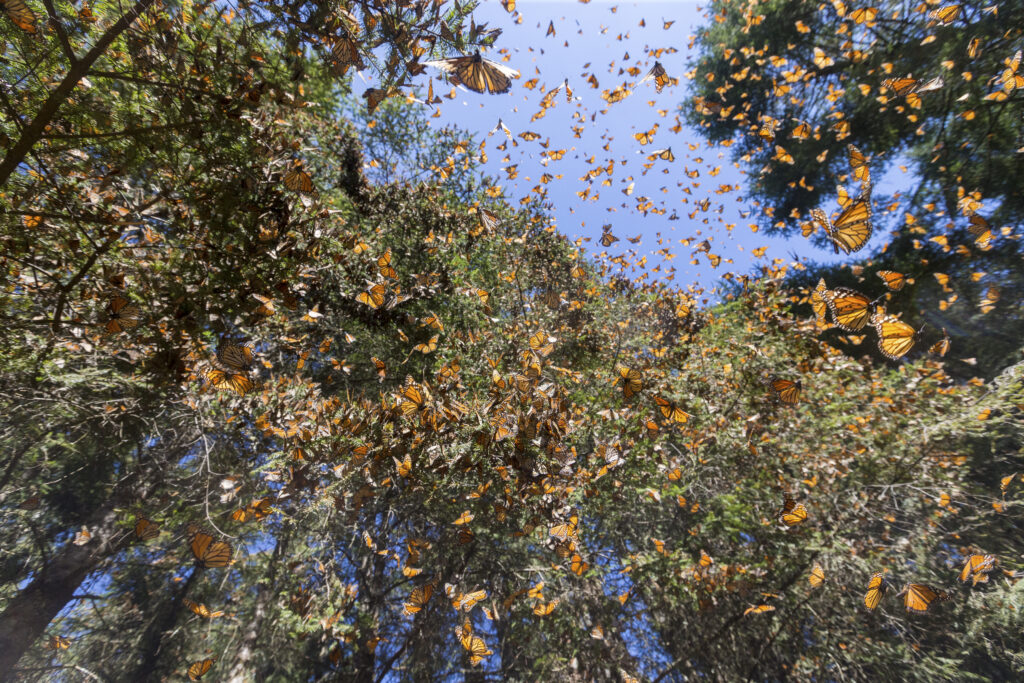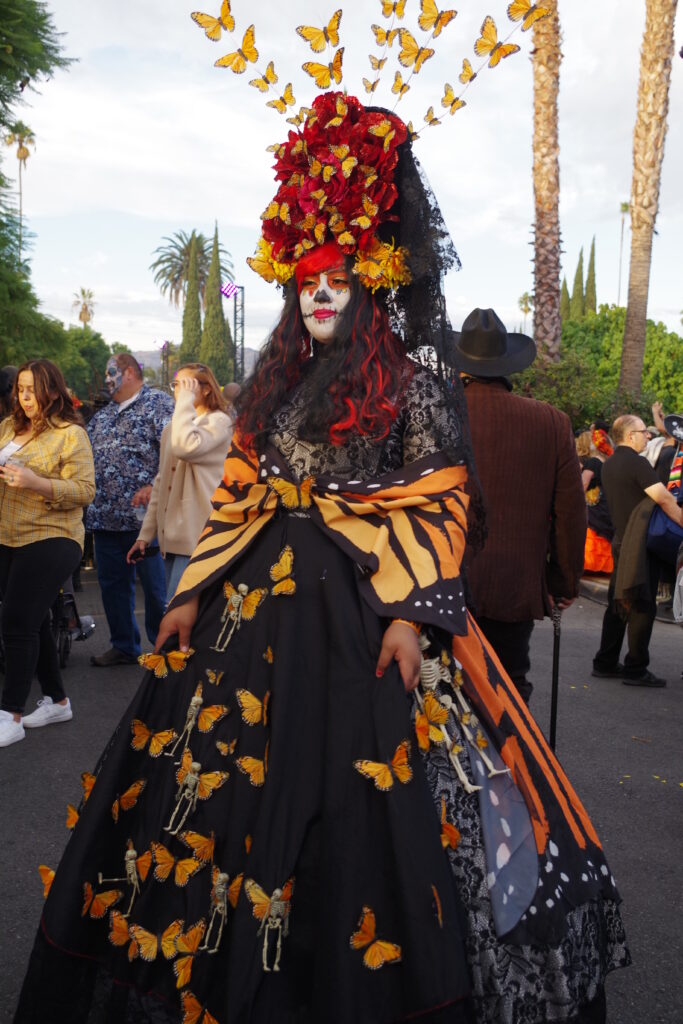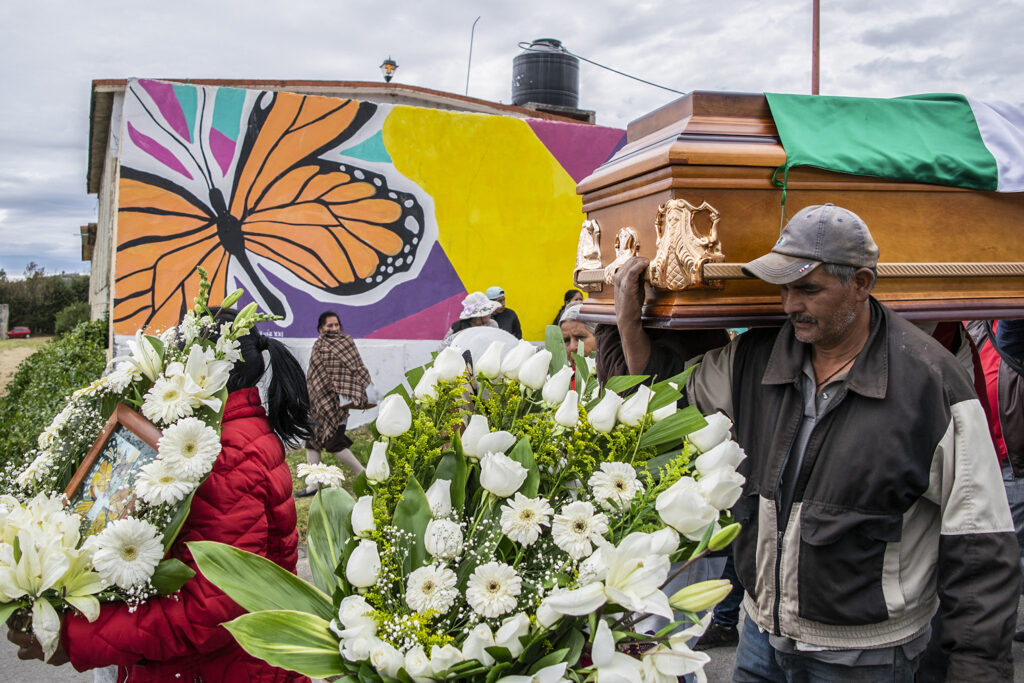Alive in the Flapping of Infinite Orange Wings
“When you stand in a monarch sanctuary, your soul is shaken, and your life is changed.”
These words, attributed to the Mexican butterfly conservationist Carlos Gottfried, echoed in my mind the first time I visited one such sanctuary during a long-term stay in Mexico in 2021. I was there to witness a famed wonder of nature: the annual southern migration of monarch butterflies.
“It’s really one of the amazing things in Mexico,” Julieta Bueno, my Spanish language instructor at the Universidad Nacional Autónoma de México, told me. In the textbook for Bueno’s class, we read about the monarchs’ incredible journey from southern Canada and the eastern U.S. to the oyamel (fir) trees in Central Mexico. Millions of butterflies cover a distance, by some accounts, of up to 3,000 miles. “You should definitely see the mariposas monarcas,” she confirmed.
What’s especially remarkable about this migration is that it involves several generations. The butterflies somehow manage to end up in the same conifer forests in Mexico where their great-great-grandparents originated. To date, biologists have yet to fully explain the mechanism of this “genetic memory” or “inner clock” that tells the butterflies where to go.
What’s more, although the typical life span of a monarch butterfly is just four to five weeks, the ones that head to Mexico in the fall delay their sexual maturity and live up to eight months, earning them the moniker the “Methuselah generation,” after the Biblical character who lived for 969 years. This same generation commences a return journey in the spring, but they die along the way, usually after they’ve reached the Gulf Coast. The next generations are left to continue north—and then the cycle begins again.
As an anthropologist, the great monarch migration captured my interest immediately.
Perhaps this seems counterintuitive. After all, anthropology literally means the “study of humans.” But the discipline has long been interested in nonhuman animals’ intimate involvements in people’s social and ceremonial lives.
Recent scholarship has expanded this insight into an approach known as “multispecies ethnography,” which looks at the complex relationships of care and exploitation between humans and other animals. These approaches focus on nonhumans not only for their ecological significance, but also in terms of their “significant otherness” from humans.
Some multispecies ethnographers look at relationships with dogs, cats, and other animals that have been closest companion species to humans. But anthropologists are also unearthing human-nonhuman connections with less expected counterparts—from fungi to viruses to, yes, insects. As the anthropologist Hugh Raffles writes of insects in his book Insectopedia:
“For as long as we’ve been here, they’ve been here too. Wherever we’ve traveled, they’ve been there too. … Who are they, these beings so different from us and from each other? What do they do? What worlds do they make? What do we make of them? How do we live with them? How could we live with them differently?”
Butterflies, unlike many other insects, are already familiar and well-loved creatures. What does it mean to take them seriously, not just as beautiful specimens, but as a species whose lives are ecologically and culturally intertwined with ours?
I had this question in mind when I made the trip to Santuario Piedra Herrada in Valle de Bravo, one of several butterfly sanctuaries in Mexico open to the public. Together with two of my friends, I journeyed some 80 kilometers west of Mexico City to see the butterflies in person.
Minerva, the guide, was more than willing to enlighten our group on the phenomenon of monarch migration.
The contemporary global fascination that led visitors like me to the monarchs can be traced to a 1976 article in National Geographic. The article, complete with migratory maps and vivid images, introduced the butterflies and their fascinating life cycle to the world. Gottfried himself cites reading the same article as the beginning of his inspiration to protect the butterflies. The first organized efforts to protect the butterflies and build sanctuaries in Mexico began not long after in the 1980s.
Local communities in Mexico, however, had always ascribed significant meanings to monarchs. As we trekked up the peak where the butterflies had settled, Minerva shared that long before the existence of sanctuaries, her grandparents had awaited the yearly arrival of the butterflies. The monarchs’ return is often associated with Día de los Muertos (Day of the Dead), which is celebrated from October 31 to November 2. Since precolonial times, some Indigenous communities understood the returning butterflies to hold the spirits of the departed who were making their annual visit to the land of the living.
The butterflies’ annual migration cycle has even helped structure how some communities in Mexico and the Mexican diaspora keep track of the passing of time and make sense of their place in the world. Indigenous Purépecha communities, for instance, are said to have timed their harvests to align with the return of the butterflies each year. Scholars José Ramón Fabelo Corzo and José Antonio Pérez Diestre recount a conversation with an Indigenous person who told them that “the insects’ growth [were] a reflection of the cosmic ‘cycle of life,’ the maturity, death, and rebirth.”
Indeed, the monarchs’ annual departure and arrival continue to serve as a vivid reminder of the recurrent patterns of all life, including humans.
Today, however, the butterflies are serving not as a sign of constancy but of change.
As they have done for thousands of years, the butterflies have kept coming annually. But the numbers have dwindled recently due to climate change, habitat loss, and other environmental pressures. Just this year, the monarchs were classified as “endangered” for the first time on the International Union for Conservation of Nature’s Red List of Threatened Species. Ominously, a National Geographic article warns, “The epic 3,000-mile monarch butterfly migration may become a thing of the past.”
Not even the monarch butterflies’ status as an iconic and “charismatic species” may be enough to protect them and their habitats.
The monarchs’ annual departure and arrival serve as a vivid reminder of the recurrent patterns of all life, including humans.
The fact that monarchs migrate so far and wide is part of what makes protecting them challenging from a political and legal standpoint. On one hand, as the anthropologist and multispecies ethnographer Columba González-Duarte points out, the monarchs have been used as a symbol of a shared North American ecology connecting Canada, the U.S., and Mexico. In recent years, the three countries have collaborated on monarch monitoring and protection efforts through the Commission for Environmental Cooperation.
But monarchs have also become vulnerable in part because of the constant flows of goods and people linking the three highly industrialized, capitalist countries. These cross-border activities, which have exploited and disrupted environments and communities, have contributed to what González-Duarte calls the “eco-social degradation” that imperils the monarchs’ future.
What’s more, the three countries have not always been on the same page about how to protect monarchs. At times, their governments have blamed one another for the dwindling populations. In 2004, for instance, Mexico’s environment department attributed the threats the butterflies face to conditions in the U.S. and Canada, including the weather and genetically modified crops.
Mexican environmental activists, meanwhile, have called upon their own government to take more responsibility for the violence that has befallen Mexico’s own forests and its defenders. In 2020, two butterfly conservationists were killed in the state of Michoacán. Many attributed their deaths to ongoing conflict with organized crime networks participating in illegal logging in the areas the butterfly defenders were trying to protect. Now, some Indigenous communities in Michoacán are organizing to defend themselves and the oyamel forests from these criminal networks.
Whether these and other human efforts will be enough to save the monarchs remains to be seen.
Back in that lovely and cold oyamel forest, almost 3,000 meters above sea level, we hiked for about an hour, gaining over 100 meters in elevation while looking for the butterflies.
“They change spots within the sanctuary,” explained Minerva. “When it gets colder, they go farther down,” she added. (Scientific studies have also found butterflies to be very sensitive to microclimates in the oyamel forests.)
Finally, we arrived at the place where they had nested. Thousands of butterflies were suspended in the tree trunks and branches above us. At first, there was barely any sign of life, but as the clouds gave way to slivers of sunlight, the butterflies began to take flight.
All the concerns over our shared fates and intertwined vulnerabilities suddenly seemed distant in that moment. I could only look up with wonder at the forest canopy, alive with the flapping of infinite orange wings.





































